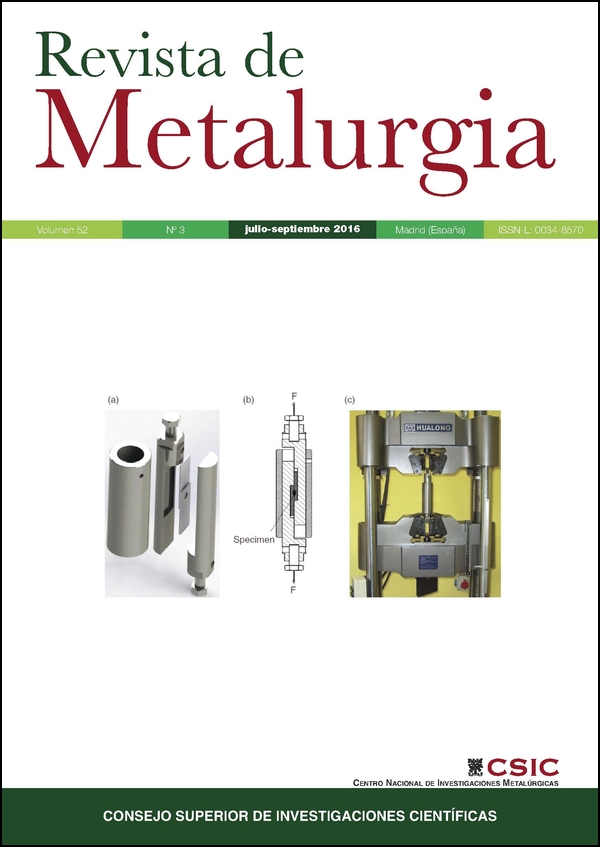Effect of Ekabor 2 powder on the mechanical properties of pure iron powder metal compacts
DOI:
https://doi.org/10.3989/revmetalm.073Keywords:
Conventional sintering, Ekabor 2, Mechanical properties, Powder metal compact, Pure ironAbstract
Ekabor 2 powder of different weights, used by V type powder mixture was mixed with pure iron powder. Specimens were created by dry pressing into die followed by cold isostatic press at a pressure of 100 bar for purpose of resizing. The conventional sintering process at 900 °C and 950 °C was carried out for 4 h using conventional furnaces. Specimens were gradually cooled by air. The sintered pellets were examined in terms of density, wear abrasion, surface roughness and hardness at 900 °C and 950 °C. Microstructure of pellets was observed with optic microscope. The results show that the hardness gradually increased with additions of 0 wt. % to 10 wt. % of Ekabor 2 however, after 10 wt. %, this hardness tended to decrease.
Downloads
References
Barut, N., Yavuz, D., Kayali, Y. (2014). Investigation of the kinetics of borided AISI 420 and AISI 5140 steels. AKU J. Sci. Eng. 14 (1), 1–8. http://dx.doi.org/10.5578/fmbd.7356
Çalik, A. (2013). Effect of powder particle size on the mechanical properties of boronized EN H320 LA steel sheets. ISIJ International 53 (1), 160–164. http://dx.doi.org/10.2355/isijinternational.53.160
Çalik, A. Karaka?, M.S., Uçar, N., Ünüvar, F. (2014). Boriding kinetics of pure cobalt. Kovove Mater. 52 (2), 107–112.
Çavdar, U., Atik, E. (2011). Conventional and Rapid Sintering Techniques. CBU Soma Vocational School Technical Sciences Journal 1, 2–6.
Çavdar, U., Atik, E. (2014a). Investigation of conventional and induction sintered iron and iron based powder metal compacts. JOM 66 (6), 1027–1034. http://dx.doi.org/10.1007/s11837-014-0977-0
Çavdar, U., Atik, E. (2014b). Properties of Boronized, Carbonitrided and Steamed Iron-Based Compacts. Mater Test. 56 (2), 126–130. http://dx.doi.org/10.3139/120.110533
Çavdar, U., Ünlü, B.S., Pinar, A.M., Atik, E. (2015). Mechanical properties of heat treated iron based compacts. Mater. Design 65, 312–317. http://dx.doi.org/10.1016/j.matdes.2014.09.015
Çelik, O.N., Akbayir, O., Gasan, H., Er, U., Aydınbeyli, N. (2008). Abrasive wear properties of borided AISI 1030 steel. Eng & Arc. Fac. Eskisehir Osmangazi University 21 (1), 71–85.
Clark, D.E., Folz, D.C., Schulz, R.L., Fathi, Z., Cozzi, A.D. (1993). Recent Developments in the Microwave Processing of Ceramics. MRS Bulletin 18, 41–46.
Fichtl, W. (1981). Boronizing and its practical applications. Mater. Design 2 (6), 276–286. http://dx.doi.org/10.1016/0261-3069(81)90034-0
German, R.M. (1996). Sintering Theory and Practice, Ed. John Wiley & Sons, USA, pp. 313–362.
German, R.M. (2005). Powder Metallurgy & Particulate Materials Processing, Ed. Metal Powder Industry, New Jersey, USA.
Günen, A., Çarbo?a, C., Kurt, B., Orhan, N. (2013). The Effect of Boron Powder Particle Size Used in Boriding Process on the Coating Layer. Nevsehir University Journal of Science 2 (1), 12–19.
Juijerm, P. (2014). Diffusion Kinetics of Different Boronizing Processes on Martensitic Stainless Steel AISI 420. Kovove Mater. 52 (4), 231–236.
Jurci, P., Hudakova, M., Kusy, M. (2012). Nature of Phases in Boronized H11 Hot Work Tool Steel. Kovave Mater. 50 (3), 177–184. http://dx.doi.org/10.4149/km_2012_3_177
Kasai, T., Ozaki, Y., Noda, H., Kawasaki, K., Tenamoto, K. (1989). Laser Sintered Barium Titanate. J. Am. Ceram. Soc. 72 (9), 1716–1718. http://dx.doi.org/10.1111/j.1151-2916.1989.tb06309.x
Mitutoyo (2009). Surface Roughness Measurement, Bulletin 1984, Mitutoyo America Corporation, http://www.mitutoyo.com/wpcontent/uploads/2012/11/1984_Surf_Roughness_PG.pdf
Ptacinova, J., Drienovsky, M., Palcut, M., Cicka, R., Kusy, M., Hudakova, M. (2015). Oxidation stability of boride coatings. Kovove Mater. 53 (3), 175–186.
Schatt, W., Wieters, K.P. (1997). Powder Metallurgy: Processing and Materials, European Powder Metallurgy Association (EPEMA), England. Ta?tan, F., Akgün, S., ?ahin, S. (2009). Analysis of effect of material composition to the properties of ferroboron layer in borozing. 5th International Advanced Technologies Symposium (IATS'09), Karabuk, Turkey.
Turku, N., Do?an, S., Uçar, N., Calik, A. (2014). The effect of boriding time on hardness values of low carbon micro alloyed steels. SDU Journal of Science 9 (2), 147–151.
Upadhya, K. (1987). Sintering Kinetics of ceramics and Composites in the plasma environment. JOM 39 (12), 11–13. http://dx.doi.org/10.1007/bf03257562
Usta, M., Ekmekçiler, E. (2010). The Kinetics and Mechanical Study of borided iron aluminide (FeAl). Kovove Mater. 48 (4), 249–255. http://dx.doi.org/10.4149/km_2010_4_249
Published
How to Cite
Issue
Section
License
Copyright (c) 2016 Consejo Superior de Investigaciones Científicas (CSIC)

This work is licensed under a Creative Commons Attribution 4.0 International License.
© CSIC. Manuscripts published in both the printed and online versions of this Journal are the property of Consejo Superior de Investigaciones Científicas, and quoting this source is a requirement for any partial or full reproduction.All contents of this electronic edition, except where otherwise noted, are distributed under a “Creative Commons Attribution 4.0 International” (CC BY 4.0) License. You may read here the basic information and the legal text of the license. The indication of the CC BY 4.0 License must be expressly stated in this way when necessary.
Self-archiving in repositories, personal webpages or similar, of any version other than the published by the Editor, is not allowed.


















